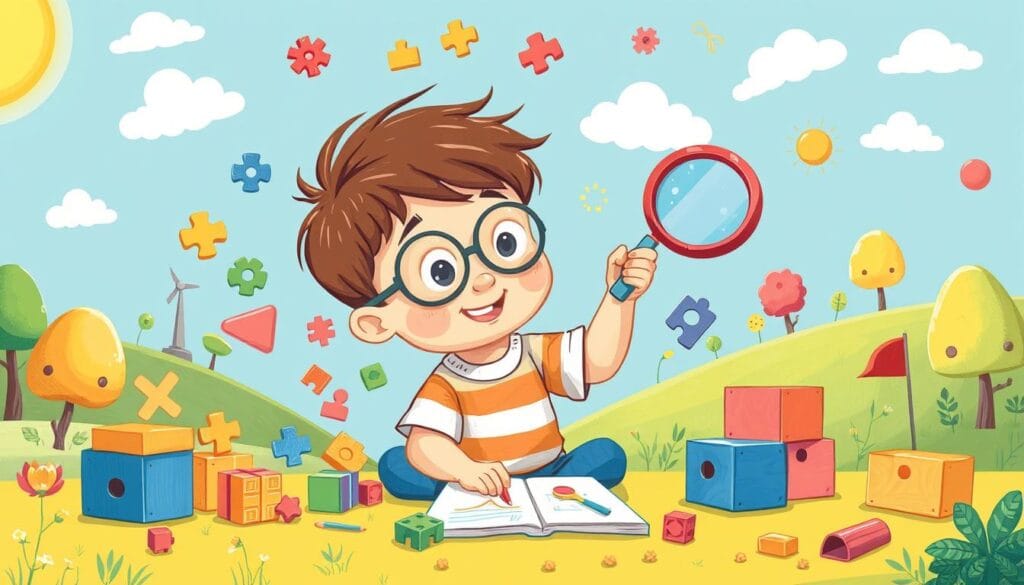How to Overcome Problems with Your Child
Raising a child is both rewarding and challenging. It involves dealing with child development, learning disabilities, and mental health issues. This can feel overwhelming, leaving many parents unsure.
Yet, with the right strategies and empathy, we can help our children overcome obstacles. This way, they can build a brighter future.

In this guide, we’ll explore solving problems with your child. We’ll use the knowledge of experts and the experiences of other parents. Together, we’ll find practical ways to support your child’s growth and strengthen your family bond.
Key Takeaways
- Understand the importance of problem-solving in child development
- Learn to distinguish between supportive and enabling behaviors
- Discover essential steps to overcome challenges with your child
- Build effective communication channels for open dialogue
- Develop emotional intelligence and coping strategies
Understanding the Importance of Problem-Solving in Child Development
Problem-solving skills are key for a child’s growth in many areas. They help kids think deeply, weigh options, and understand others’ views. These skills boost a child’s confidence and ability to make good choices, preparing them for life.
Cognitive Development Benefits
Letting kids solve problems on their own is vital. It builds important life skills and boosts emotional smarts. By solving conflicts, kids learn to communicate, compromise, and work together. Studies show kids who solve problems grow stronger and see challenges in a new light.
Emotional Growth Impact
Managing feelings while solving problems helps kids grow emotionally. Preschoolers who solve problems by themselves get better at thinking and being independent. When kids solve problems with friends, they make strong friendships and learn to work together.
Social Skills Enhancement
Dealing with conflicts helps kids learn to solve problems. While adults must step in for safety, letting kids handle some conflicts builds trust and teamwork. Kids who are good at solving problems tend to be more confident and successful in school and life.
“Children who engage in problem-solving activities individually or within a group become more resilient and develop a new perspective on problems.”
| Benefit | Impact on Child Development |
|---|---|
| Cognitive Development | Enhances critical thinking, emotional intelligence, and autonomy. |
| Emotional Growth | Develops emotional management, self-confidence, and resilience. |
| Social Skills | Strengthens communication, cooperation, and positive peer relationships. |
How to Overcome Problems with Your Child
Parenting is rewarding but also challenging. Every family faces problems. But, with the right parenting techniques, you can tackle these challenges. This helps your child learn important child behavior management and family problem-solving skills.
The key is a step-by-step approach to solving problems. This approach empowers you and your child.
- Define the Problem: Clearly identify the issue. Be specific and avoid subjective language. This is the first step to solving the problem.
- Understand the Cause: Find out why the problem exists. Is it a behavior issue, a communication problem, or something else? Knowing the cause is crucial.
- Brainstorm Solutions: Get your child involved in finding solutions. List all possible solutions, no matter how unusual. This encourages creativity and critical thinking.
- Evaluate Options: Talk about the good and bad of each solution. Think about how easy it is to do, its impact, and how it affects your family.
- Implement the Solution: Choose the best solution and start doing it. Let your child help with this to improve their problem-solving skills.
- Assess the Outcome: Check if the solution worked. If not, try something else. Keep trying until you find a solution.
By following these steps with your child, you’re not just solving the problem. You’re also teaching them valuable problem-solving skills. This teamwork strengthens your family bond and helps your child develop a positive, resilient mindset.
“The World Economic Forum lists problem-solving as one of the top ten skills required in the world of work for 2025.”
Every family is different, and what works for one might not work for another. Be flexible, seek help when needed, and enjoy the journey of parenting techniques and child behavior management. It’s a chance to grow together as a family.
Distinguishing Between Supporting and Enabling Behaviors
As a parent, it’s key to know the difference between positive parenting techniques and enabling behaviors. Supportive parenting helps your child face challenges. But enabling can actually hold them back.
Signs of Supportive Parenting
- Learning about your child’s condition and treatment options
- Acknowledging your child’s feelings and providing comfort
- Offering practical assistance without taking over tasks
- Modeling healthy coping strategies and problem-solving skills
- Setting clear boundaries and consistently enforcing rules
Recognizing Enabling Patterns
Enabling comes from a place of love and protection. But it can harm more than help. Signs of enabling include:
- Allowing your child to avoid uncomfortable situations
- Covering up for your child’s mistakes or mistakes
- Inconsistently enforcing rules and consequences
- Taking on tasks that your child is capable of handling themselves
Finding the Right Balance
Finding the right balance between support and enablement is crucial. It’s about giving the right help without stopping your child’s growth. Getting professional advice can help you find this balance and support your child’s development.
“Nearly every parent grapples with the question ‘am I helping or enabling?’ at some point.”
Essential Problem-Solving Steps for Parents
As a parent, you are key in teaching your child to solve problems. By using a structured method, you help them tackle challenges now and in the future. This makes them independent, resilient, and ready for any obstacle.
The main steps in solving problems for parents are:
- Identifying the Problem Clearly: Encourage your child to clearly state the problem. This helps them understand it better and find a solution.
- Understanding the Root Cause: Help your child find out what’s really causing the problem. This deep look can reveal key insights and guide to good solutions.
- Brainstorming Possible Solutions: Have a brainstorming session together. Come up with many solutions without judging. This boosts creativity and critical thinking.
- Evaluating the Pros and Cons: Look at each solution’s good and bad points. Think about the consequences and implications. This helps your child make smart choices.
- Implementing the Chosen Solution: Pick the best solution and work together to do it. Monitor the process and offer help when needed.
- Assessing the Effectiveness: Check if the solution worked after it’s done. Make changes if it didn’t. This step makes the problem-solving process stronger and teaches your child from their experiences.
By following this structured approach, you help your child with parenting strategies, family conflict resolution, and child problem-solving techniques. This not only solves current problems but also prepares your child for future challenges on their own.
| Key Benefit | Impact |
|---|---|
| Cognitive Development | Improves critical thinking, logical reasoning, and decision-making. |
| Emotional Growth | Builds resilience, self-confidence, and emotional management during problem-solving. |
| Social Skills | Develops communication, collaboration, and empathy for solving problems in social settings. |

Remember, solving problems is best done together with your child. By guiding them through this structured method, you help them develop the skills and mindset to face challenges all their lives.
Building Effective Communication Channels
Good communication is key to a strong bond between parents and children. By learning to listen well, creating safe places to talk, and understanding body language, you can have deep and helpful conversations with your child.
Active Listening Techniques
Active listening means really focusing on what your child is saying. It’s about understanding their view and responding thoughtfully. This builds trust and lets your child share their feelings freely. Make sure to look at them, don’t interrupt, and show you care about their feelings.
Creating Safe Spaces for Discussion
It’s important to make a place where your child feels safe to share their thoughts and worries. Don’t judge or shut them down. Instead, create a space where they can talk openly. This helps them feel heard and understood, which is the first step to solving problems together.
Non-Verbal Communication Cues
Watch your child’s body language, facial expressions, and how they sound. These clues can tell you a lot about how they’re feeling. By paying attention to these signs, you can improve your communication and grow a stronger, more trusting relationship.
Talking well with your child is more than just sharing information. It’s about building a strong, meaningful connection that helps them grow. By learning these important skills, you can face challenges together, strengthen your bond, and help your child thrive.
Age-Appropriate Problem-Solving Strategies
Helping kids solve problems is key in their child development stages. As parents, it’s vital to use age-specific parenting techniques. This ensures kids can handle challenges well. Let’s look at problem-solving for kids strategies for different ages.
For preschoolers, show them how to solve problems through play. By calmly solving issues, you teach them how to think. Creative play and DIY projects boost their imagination and cognitive flexibility.
When kids get older, help them solve simple family problems. Teach them a step-by-step problem-solving process. This improves their critical thinking and makes them more independent and responsible.
Teenagers need to think critically and consider different views. Share problem-solving stories that spark their creative thinking and empathy. Let them learn from failures and grow. This builds emotional intelligence and self-reliance.
By matching problem-solving for kids strategies to their child development stages, you empower them. They’ll face life’s challenges with confidence and resilience. This prepares them for success in the long run.
Developing Emotional Intelligence in Children
Emotional intelligence is key for solving problems. It’s important to help kids understand and manage their feelings. This way, they can face life’s challenges with strength and kindness.
Understanding Emotions
Teaching kids to recognize and name their feelings is the first step. Talk to them about different emotions, like happiness and sadness. Let them share their feelings without fear of being judged.
It’s important to tell them that all feelings are valid and normal.
Self-Regulation Skills
Teaching kids to control their emotions is crucial. Show them ways to calm down, like deep breathing. Help them find healthy ways to deal with their feelings.
Empathy Development
Teaching kids to be empathetic is vital. Encourage them to think about others’ feelings. Roleplay and read books that show different emotional experiences.
By teaching emotional intelligence, you help kids grow strong and aware. They’ll have better relationships and mental health. This will help them succeed in life.
| Key Statistic | Importance |
|---|---|
| Children with higher emotional intelligence experience greater academic success, improved mental health, and more positive relationships. | Highlights the far-reaching benefits of developing emotional intelligence in children. |
| Research shows that children develop empathy by experiencing it from others. | Underscores the importance of parents and caregivers modeling empathetic behavior. |
| A 2016 study emphasized that emotional intelligence can be improved through targeted educational programs where parents and teachers talk to kids about feelings. | Suggests that intentional, guided interventions can effectively enhance emotional intelligence in children. |
“Emotions are messages, not mud for wallowing.”
Teaching kids about emotional intelligence is vital for their growth. By teaching them about emotions, self-control, and empathy, you prepare them for life’s challenges. They’ll face these with strength and kindness.
Creating Structured Support Systems
Setting up structured support systems helps kids deal with life’s ups and downs. By having regular routines, clear rules, and fair consequences, you help your child grow. They learn to solve problems and handle feelings in a healthy way.
Get your child involved in making family rules and schedules. This makes them feel responsible and connected. Work with teachers and other caregivers to make sure support is consistent everywhere your child goes.
Good sleep is key for kids to handle daily stress. It’s also vital for their mind and heart to grow. Having meals together and bedtime rituals gives them stability and a sense of belonging.
Spending 10-15 minutes playing with your child a few times a week helps them understand their feelings. Teaching them to behave well through positive discipline helps them manage their actions.
Talking openly, listening well, and creating a safe space is important. It strengthens your bond and helps your child deal with their emotions. Learning to handle feelings prevents them from feeling overwhelmed.
Help your child make friends and join in community activities. This boosts their mental and emotional health. Teaching them to be kind, respectful, and accepting helps them build strong relationships.
| Effective Strategies for Structured Support Systems | Key Benefits |
|---|---|
| Consistent routines and schedules Clear expectations and appropriate consequences Collaborative approach with teachers, therapists, and other caregivers Prioritizing sleep and establishing healthy sleep habits Dedicated family play time Positive discipline strategies Open communication and emotion coaching Encouraging social connections and community involvement Fostering empathy, respect, and acceptance | Enhance child’s problem-solving skills and coping mechanisms Provide stability and connection for the child Support mental and emotional development Improve parent-child relationship and emotional well-being Promote healthy social relationships and overall well-being |

Dealing with Behavioral Challenges
As your child grows, you may face various behavioral issues. These can range from lying and screen time dependency to aggressive tendencies. It’s crucial to address these problems calmly and consistently for your child’s development.
Common Behavioral Issues
Children often lie to get attention or avoid responsibility. Setting clear rules for screen time and food can prevent dependency. Ignoring disrespect or whining can make these behaviors worse.
Positive Reinforcement Methods
Positive reinforcement is key to changing behavior. Rewarding good behavior helps your child develop important skills. Techniques like redirection and the ABC formula can also help manage tough behaviors.
Setting Healthy Boundaries
Clear expectations and consequences are essential for your child’s growth. Consistently enforcing these boundaries helps manage behavior. If problems persist, seeking professional help may be necessary.
Don’t hesitate to see other articles on my bloghttps://www.skillsraisingkids.com/
FAQ
What are the benefits of developing problem-solving skills in children?
Problem-solving skills are key for kids’ growth. They help kids think, choose wisely, and respect others. These skills boost confidence and decision-making.
Children with these skills do better in social and work settings. They’re ready for the future.
How can parents distinguish between supporting and enabling behaviors when dealing with children’s challenges?
Supportive parenting means learning about the child’s needs and feelings. It’s about being there and helping practically. It also means teaching healthy ways to cope and setting clear rules.
Enabling behaviors, on the other hand, can hold kids back. They include avoiding problems and making excuses. Finding the right balance is key to helping kids grow.
What are the essential problem-solving steps for parents to help their children?
The first step is to clearly identify the problem. Then, understand its cause. Next, brainstorm solutions without judging.
After that, weigh the pros and cons of each option. Choose a solution and put it into action. Finally, check if it worked. This teaches kids to solve problems step by step.
How can parents build effective communication channels with their children?
Good communication is vital in solving problems with kids. Listen fully and acknowledge their feelings. Make sure to avoid interrupting.
Create a safe space for talks. This means no judgment. Using non-verbal cues can also help build trust and understanding.
How can parents tailor problem-solving strategies to their child’s age and developmental stage?
Problem-solving strategies should match the child’s age and stage. For young kids, use play to teach. For older kids, involve them in solving simple problems.
Teenagers can tackle more complex issues. Encourage them to think critically and consider different views.
How can parents help develop emotional intelligence in their children?
Emotional intelligence is key for solving problems. Teach kids to recognize and share their feelings. Show them how to control their emotions and be empathetic.
Play can help kids understand and manage emotions. For older kids, discuss different viewpoints to deepen their emotional understanding.
What are some strategies for creating structured support systems for children to navigate challenges?
Creating a structured support system helps kids face challenges. Set up routines and clear expectations. Make sure consequences are fair.
Involve kids in making rules and schedules. This helps them feel responsible. Work with teachers and therapists for consistent support.
How can parents effectively address behavioral challenges in their children?
Addressing behavioral issues starts with identifying common problems. Use positive reinforcement and set healthy boundaries. Be calm and consistent when dealing with bad behavior.
Praise and reward good behavior. Set clear rules and consequences. This gives kids structure and helps them manage their actions.
Source Links
- Supporting vs Enabling – Child Mind Institute – https://childmind.org/article/supporting-vs-enabling-a-child-with-challenges/
- Problem-solving steps: pre-teens and teenagers – https://raisingchildren.net.au/pre-teens/behaviour/encouraging-good-behaviour/problem-solving-steps
- Benefits of Allowing Kids to Work Out Problems – Lighthouse Learning Wall – https://childrenslighthouse.com/learning-wall/benefits-of-allowing-kids-to-work-out-problems
- Importance of Problem Solving Skills in Child Development | Key Benefits and Strategies – https://sipabacus.com/in/blog/why-problem-solving-skills-are-essential-for-a-childs-development/
- 5 ways to help your child problem solve – https://www.rolemodels.me/news/5-ways-to-help-your-child-problem-solve
- Problem-solving steps for parents – https://raisingchildren.net.au/grown-ups/looking-after-yourself/communication-conflict/problem-solving-for-parents
- Power Struggles: Why We Get Stuck In Them & How to Move Toward Problem Solving – https://connectedfamilies.org/how-to-power-struggles-to-problem-solving/
- Am I Helping or Enabling My Child? – https://www.imom.com/helping-vs-enabling-child/
- What Is Enabling? A Therapist For Young Adults Explains – LA Concierge Psychologist – https://laconciergepsychologist.com/blog/what-is-enabling/
- How to address and resolve parenting and disciplining issues? – Dr. Ellie Bolgar – https://drbolgar.com/how-to-address-and-resolve-parenting-and-disciplining-issues/
- Emotion Coaching Step 5: Helping the Child Problem Solve and Setting Limits – https://www.gottman.com/blog/emotion-coaching-step-5-helping-the-child-problem-solve-and-setting-limits/
- Stop Yelling, Start Connecting with Effective Communication – https://bekindcoaching.com/blog/effective-communication/
- 10 Tips for Healthy Parent-Child Communication — Rooted Rhythm Therapy – https://www.rootedrhythm.com/blog/parents-children-communication
- How to Teach Problem-Solving Skills to Your Child: A Guide for Every Age – https://www.familycentre.org/news/post/how-to-teach-problem-solving-skills-to-your-child-a-guide-for-every-age
- 10 Ways to Teach Your Children to Be Problem Solvers – https://lvds.com/10-ways-to-teach-your-children-to-be-problem-solvers/
- Raising Emotionally Intelligent Children – HelpGuide.org – https://www.helpguide.org/family/parenting/raising-emotionally-intelligent-children
- How to Raise Emotionally Intelligent Kids – https://www.psychologytoday.com/us/blog/what-mentally-strong-people-dont-do/202409/cultivating-emotional-intelligence-in-kids-a
- 5 Steps To Nurture Emotional Intelligence in Your Child – https://www.peacefulparenthappykids.com/read/steps-to-encourage
- Healthy Mental & Emotional Development: 4 Key Building Blocks – https://www.healthychildren.org/English/healthy-living/emotional-wellness/Building-Resilience/Pages/healthy-mental-and-emotional-development-in-children-key-building-blocks.aspx
- Promoting Well-Being of Children and Families in Child Protection – https://www.fftllc.com/blog/engagement-in-child-welfare
- Effective Solutions for Common Child Behavior Problems – https://www.parents.com/common-child-behavior-problems-and-their-solutions-1094944
- Handling Challenging Behavior: 8 parent strategies – Skill Point Therapy – https://www.skillpointtherapy.com/handling-challenging-behavior-8-parent-strategies/
- Creative Tips and Tricks to Overcome Behavioral Issues with Kids at Home – Peaks Counseling – https://www.peakscounseling.com/creative-tips-and-tricks-to-overcome-behavioral-issues-with-kids-at-home/







